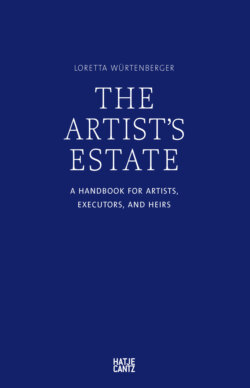Читать книгу The Artist's Estate - Группа авторов - Страница 16
1. Strategy Development
ОглавлениеTo find the right answers, it is necessary to ask the right questions. Successful administration of an estate therefore begins with an extensive strategy phase, which should take a look at the following questions:
1. In what condition is the estate?
a. What is the condition of the estate with respect to organization and conservation?
b. How is it catalogued and stored?
c. Where does the oeuvre stand within the context of art history? How recognized is it, and what is its objective quality?
2. In which structure should the estate be administered?
a. Was the intention of the deceased artist verbalized?
b. Should the estate be administered in a private form?
c. Should it be administered in an institutionalized form?
d. Profit or nonprofit definition of objectives?
3. Who should administer the estate?
a. Family
b. Third party
c. Role and composition of advisory bodies
4. What objectives do I want to achieve through working with the estate in the short, middle, and long term?
a. Definition of objectives
b. How do I achieve the objectives?
I. How do I work with museums?
II. How do I work with scholarship?
III. How do I work with the art market?
IV. Will a catalogue raisonné be necessary?
V. Will an authentication committee be necessary?
5. How do I finance the achieving of these objectives?
6. Should the estate be set up for an indefinite or definite period?
Such a strategy phase requires time, and some estates take as long as three years—a period in which all external activities are reduced to a minimum. The Gordon Parks Foundation, which was created in 2006 to preserve the memory of the American photographer Gordon Parks, took an even longer time. “The very first thing the foundation decided on was to catalogue all his works and not work with any museums or galleries for the first five or so years, until we uncovered what was in the archive,” the managing director Peter Kunhardt, Jr. reported.12 Similarly, the children of the Belgian painter Philippe Vandenberg13 closed the studio, blocked all sales as well as the mandates of galleries, and recalled all artworks to the studio after his sudden death. They then took the time they needed to analyze the situation, obtain opinions of their father’s art, and develop an agenda. They also discussed their relationship to one another in connection to the estate work. Looking back, daughter Hélène Vandenberghe says that this retreat was the best decision they could have made. It enabled them to ask questions and to listen—to friends of their father, friendly collectors, artists, art dealers, curators, and museum people. It was after that the siblings developed a strategy, to which they have remained true:“In 2010 we outlined our short- and long-term goals and planned the further steps we wanted to take. To this day we still follow the very script that we wrote down six years ago. It’s amazing that we intuitively felt what steps were necessary.”14
